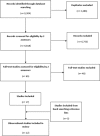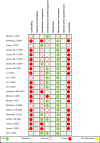Association of industry ties with outcomes of studies examining the effect of wholegrain foods on cardiovascular disease and mortality: systematic review and meta-analysis
- PMID: 31110080
- PMCID: PMC6530454
- DOI: 10.1136/bmjopen-2018-022912
Association of industry ties with outcomes of studies examining the effect of wholegrain foods on cardiovascular disease and mortality: systematic review and meta-analysis
Abstract
Objective: To determine if observational studies examining the association of wholegrain foods with cardiovascular disease (CVD) with food industry sponsorship and/or authors with conflicts of interest (COI) with the food industry are more likely to have results and/or conclusions that are favourable to industry than those with no industry ties, and to determine whether studies with industry ties differ in their risk of bias compared with studies with no industry ties.
Design: Systematic review and meta-analysis of observational studies.
Data sources: We searched eight databases from 1997 to 2017 and hand searched the reference lists of included studies.
Eligibility criteria for selecting studies: Cohort and case-control studies that quantitatively examined the association of wholegrains or wholegrain foods with CVD outcomes in healthy adults or children.
Results: 21 of the 22 studies had a serious or critical risk of bias. Studies with industry ties more often had favourable results compared with those with no industry ties, but the Confidence Interval (CI) was wide, Risk Ratio (RR)=1.44 (95% CI 0.88 to 2.35). The same association was found for study conclusions. We did not find a difference in effect size (magnitude of RRs) between studies with industry ties, RR=0.77 (95% CI 0.58 to 1.01) and studies with no industry ties, RR=0.85 (95% CI 0.73 to 1.00) (p=0.50) I2 0%. These results were comparable for studies that measured the magnitude using Hazard Ratios (HR); industry ties HR=0.82 (95% CI 0.76 to 0.88) versus no industry ties HR=0.86 (95% CI 0.81 to 0.91) (p=0.34) I2 0%.
Conclusions: We did not establish that the presence of food industry sponsorship or authors with a COI with the food industry was associated with results or conclusions that favour industry sponsors. The association of food industry sponsorship or authors with a COI with the food industry and favourable results or conclusions is uncertain. However, our analysis was hindered by the low level of COI disclosure in the included studies. Our findings support international reforms to improve the disclosure and management of COI in nutrition research. Without such disclosures, it will not be possible to determine if the results of nutrition research are free of food industry influences and potential biases.
Prospero registration number: CRD42017055841.
Keywords: bias; conflict of interest; food industry; industry sponsorship; nutrition.
© Author(s) (or their employer(s)) 2019. Re-use permitted under CC BY-NC. No commercial re-use. See rights and permissions. Published by BMJ.
Conflict of interest statement
Competing interests: None declared.
Figures




Similar articles
-
Association of food industry ties with findings of studies examining the effect of dairy food intake on cardiovascular disease and mortality: systematic review and meta-analysis.BMJ Open. 2020 Dec 4;10(12):e039036. doi: 10.1136/bmjopen-2020-039036. BMJ Open. 2020. PMID: 33277278 Free PMC article.
-
Association between industry sponsorship and author conflicts of interest with outcomes of systematic reviews and meta-analyses of interventions for opioid use disorder.J Subst Abuse Treat. 2022 Jan;132:108598. doi: 10.1016/j.jsat.2021.108598. Epub 2021 Aug 14. J Subst Abuse Treat. 2022. PMID: 34419326
-
Industry study sponsorship and conflicts of interest on the effect of unprocessed red meat on cardiovascular disease risk: a systematic review of clinical trials.Am J Clin Nutr. 2025 Jun;121(6):1246-1257. doi: 10.1016/j.ajcnut.2025.02.030. Epub 2025 May 12. Am J Clin Nutr. 2025. PMID: 40379522
-
Association between author conflicts of interest and industry-sponsorship with the favorability of outcomes of systematic reviews focusing on treatments of erectile dysfunction.Andrology. 2021 Nov;9(6):1819-1827. doi: 10.1111/andr.13064. Epub 2021 Jul 10. Andrology. 2021. PMID: 34173351
-
Reporting of conflicts of interest in meta-analyses of trials of pharmacological treatments.JAMA. 2011 Mar 9;305(10):1008-17. doi: 10.1001/jama.2011.257. JAMA. 2011. PMID: 21386079 Review.
Cited by
-
Disclosure of funding sources and conflicts of interest in evidence underpinning vitamin D and calcium recommendations in bone health guidelines.Public Health Nutr. 2022 Aug;25(8):2288-2295. doi: 10.1017/S1368980022000246. Epub 2022 Jan 24. Public Health Nutr. 2022. PMID: 35067274 Free PMC article.
-
Randomised study of the effects of sense of entitlement and conflict of interest contrarianism on researcher decision-making to work with the alcohol industry.BMC Public Health. 2024 Jun 24;24(1):1680. doi: 10.1186/s12889-024-18961-5. BMC Public Health. 2024. PMID: 38914989 Free PMC article.
-
The 'snowball effect': short and long-term consequences of early career alcohol industry research funding.Addict Res Theory. 2021 Jul 22;30(2):119-125. doi: 10.1080/16066359.2021.1952190. eCollection 2022. Addict Res Theory. 2021. PMID: 35299957 Free PMC article.
-
Investigation of Risk Of Bias due to Unreported and SelecTively included results in meta-analyses of nutrition research: the ROBUST study protocol.F1000Res. 2019 Oct 16;8:1760. doi: 10.12688/f1000research.20726.2. eCollection 2019. F1000Res. 2019. PMID: 32117567 Free PMC article.
-
Low-carbohydrate diets for type 1 diabetes mellitus: A systematic review.PLoS One. 2018 Mar 29;13(3):e0194987. doi: 10.1371/journal.pone.0194987. eCollection 2018. PLoS One. 2018. PMID: 29596460 Free PMC article.
References
-
- National Academies of Sciences, Engineering, and Medicine. Redesigning the process for establishing the dietary guidelines for Americans. 2017. https://www.nap.edu/catalog/24883/redesigning-the-process-for-establishi... (accessed Nov 2017). - PubMed
-
- National Academies of Sciences, Engineering, and Medicine. Optimizing the process for establishing the Dietary Guidelines for Americans: the selection process. 2017. https://www.nap.edu/catalog/24637/optimizing-the-process-for-establishin... (accessed Nov 2017). - PubMed
-
- U.S. Department of Health and Human Services and U.S. Department of Agriculture. 2015 – 2020 Dietary Guidelines for Americans. 8th edn, 2015. Available: https://health.gov/dietaryguidelines/2015/guidelines/ (accessed Dec 2017).
-
- National Health and Medical Research Council. Department of Health and Ageing. Australian Dietary Guidelines. Canberra, Commonwealth of Australia: NHMRC, 2013.
Publication types
MeSH terms
LinkOut - more resources
Full Text Sources
